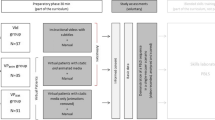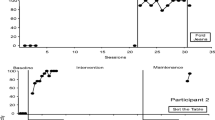Abstract
Background
Interactive media are effective tools in teaching and allow for self-directed study, which develops skills for life-long learning among health professionals. With this type of study, the learner can review material at his/her own pace and target areas that require emphasis. Pediatric residents require an accurate understanding of developmental milestones in children of various ages and their normal variations. The best representation of developmental milestones requires video recordings of children demonstrating appropriate skills. However, such recordings are not always available, so printed materials are most often used. In this realm, a computer-based interactive learning tool using animated cartoons gives flexibility for presentation using drawings. We compared pediatric residents’ knowledge of developmental milestones in neonates to 5-year-olds before and after study with either an interactive DVD or paper-based materials.
Methods
A team of physicians and educational specialists in Texas Tech University Health Sciences Center produced an interactive DVD containing animated cartoons and questions. Residents were divided into an intervention group that used the DVD and a control group that used traditional paper-based materials. Each group’s improvement [or increase] in knowledge was measured.
Results
Compared with the 17 residents in the control group, the 37 in the intervention group tended to acquire more knowledge about developmental milestones. The mean scores at T1, T2, and T3 doubled from the initial scores in the intervention group, while no difference was observed in the control group.
Conclusion
An interactive educational DVD can be an effective supplement to improve residents’ knowledge of developmental milestones.
Similar content being viewed by others
References
King KP, Lawler PA. Trends and issues in the professional development of teachers of adults. New Dir Adult Contin Educ 2003;98:5–13.
Knowles M. Self-directed learning. A guide for learners and teachers. Englewood Cliffs: Prentice Hall/Cambridge, 1975.
Lawler PA, King KP. Changes, challenges, and the future. New Dir Adult Contin Educ 2003;98:83–91.
Merriam SB. Andragogy and self-directed learning: pillars of adult learning theory. New Dir Adult Contin Educ 2001;89:3–14.
Ruiz-Casares M, Heymann J. Children home alone unsupervised: modeling parental decisions and associated factors in Botswana, Mexico, and Vietnam. Child Abuse Negl 2009;33:312–323.
Kandasamy T, Fung K. Interactive Internet-based cases for undergraduate otolaryngology education. Otolaryngol Head Neck Surg 2009;140:398–402.
Ochoa JG, Wludyka P. Randomized comparison between traditional and traditional plus interactive Web-based methods for teaching seizure disorders. Teach Learn Med 2008;20:114–117.
Van Dijken PC. Evaluation of an online, case-based interactive approach to teaching pathophysiology. Med Teach 2008;30:e131–136.
Wong G, Greenhalgh T, Pawson R. Internet-based medical education: a realist review of what works, for whom and in what circumstances. BMC Med Educ 2010;10:12.
Walsh K. Online educational tools to improve the knowledge of primary care professionals in infectious diseases. Educ Health (Abingdon) 2008;21:64.
Wilson AS. Development of an interactive learning tool for teaching rheumatology—a simulated clinical case studies program. Rheumatology 2006;45:1158–1161.
Lerner C, Gaca AM, Frush DP, Hohenhaus S, Ancarana A, Seelinger TA, et al. Enhancing pediatric safety: assessing and improving resident competency in life-threatening events with a computer-based interactive resuscitation tool. Pediatr Radiol 2009;39:703–709.
Nousiainen M, Brydges R, Backstein D, Dubrowski A. Comparison of expert instruction and computer-based video training in teaching fundamental surgical skills to medical students. Surgery 2008;143:539–544.
Sargeant J. Interactive on-line continuing medical education: physicians’ perceptions and experiences. J Contin Educ Health Prof 2004;24:227–236.
Dumont-Mathieu TM, Bernstein BA, Dworkin PH, Pachter LM. Role of pediatric health care professionals in the provision of parenting advice: a qualitative study with mothers from 4 minority ethnocultural groups. Pediatrics 2006;118:e839–848.
Silverstein M, Sand N, Glascoe FP, Gupta VB, Tonniges TP, O’Connor KG. Pediatrician practices regarding referral to early intervention services: is an established diagnosis important? Ambul Pediatr 2006;6:105–109.
Boreman CD, Thomasgard MC, Fernandez SA, Coury DL. Resident training in developmental/behavioral pediatrics: where do we stand? Clin Pediatr (Phila) 2007;46:135–145.
Glascoe FP. Early detection of developmental and behavioral problems. Pediatr Rev 2000;21:272–279.
Glascoe FP. Detecting and addressing developmental and behavioral problems in primary care. Pediatr Nurs 2000;26:251–257.
Wallis KE, Smith SM. School health developmental screening in pediatric primary care: the role of nurses. J Spec Pediatr Nurs 2008;13:130–134.
Nalven LM. Teaching pediatric residents about early intervention and special education. J Dev Behav Pediatr 1997;18:371–376.
Bente G, Petersen A, Kramer NC, de Ruiter JP. Transcript-based computer animation of movement: evaluating a new tool for nonverbal behavior research. Behav Res Methods Instrum Comput 2001;33:303–310.
Crano WD, Brewer MB. Principles and Methods of Social Research. Mahwah NJ: Lawrence Erlbaum Associates, 2002.
Foreman KB, Morton DA, Musolino GM, Albertine KH. Design and utility of a web-based computer-assisted instructional tool for neuroanatomy self-study and review for physical and occupational therapy graduate students. Anat Rec B New Anat 2005;285:26–31.
Bailey CM, Hsu CT, DiCarlo SE. Educational puzzles for understanding gastrointestinal physiology. Am J Physiol 1999;276:S1–18.
Mayer RE, Massa LJ. Three facets of visual and verbal learners: cognitive ability, cognitive style, and learning preference. J Educ Psychol 2003;95:833–848.
Bridgemohan CF, Levy S, Veluz AK, Knight JR. Teaching paediatric residents about learning disorders: use of standardised case discussion versus multimedia computer tutorial. Med Educ 2005;39:797–806.
Kutner L, Olson CK, Schlozman S, Goldstein M, Warner D, Beresin EV. Training pediatric residents and pediatricians about adolescent mental health problems: a proof-of-concept pilot for a proposed national curriculum. Acad Psychiatry 2008;32:429–437.
Luker KR, Sullivan ME, Peyre SE, Sherman R, Grunwald T. The use of a cognitive task analysis-based multimedia program to teach surgical decision making in flexor tendon repair. Am J Surg 2008;195:11–15.
Obeso VT, Gordon DL, Issenberg SB, Baker JW, Clark RG, Reynolds PS, et al. A multicenter study to provide evidence of construct validity in a computer-based outcome measure of neurology clinical skills. Acad Med 2005;80:S71–74.
Vivekananda-Schmidt P, Hassell AB, McLean M. The evaluation of multimedia learning packages in the education of health professionals: experience of a musculoskeletal examination package. Nurse Res 2004;11:43–55.
Clark RE. Reconsidering research on learning from media. Rev Educ Res 1983;53:445–459.
Author information
Authors and Affiliations
Corresponding author
Rights and permissions
About this article
Cite this article
Leiner, M., Krishnamurthy, G.P., Blanc, O. et al. Comparison of methods for teaching developmental milestones to pediatric residents. World J Pediatr 7, 161–166 (2011). https://doi.org/10.1007/s12519-011-0269-5
Received:
Accepted:
Published:
Issue Date:
DOI: https://doi.org/10.1007/s12519-011-0269-5




